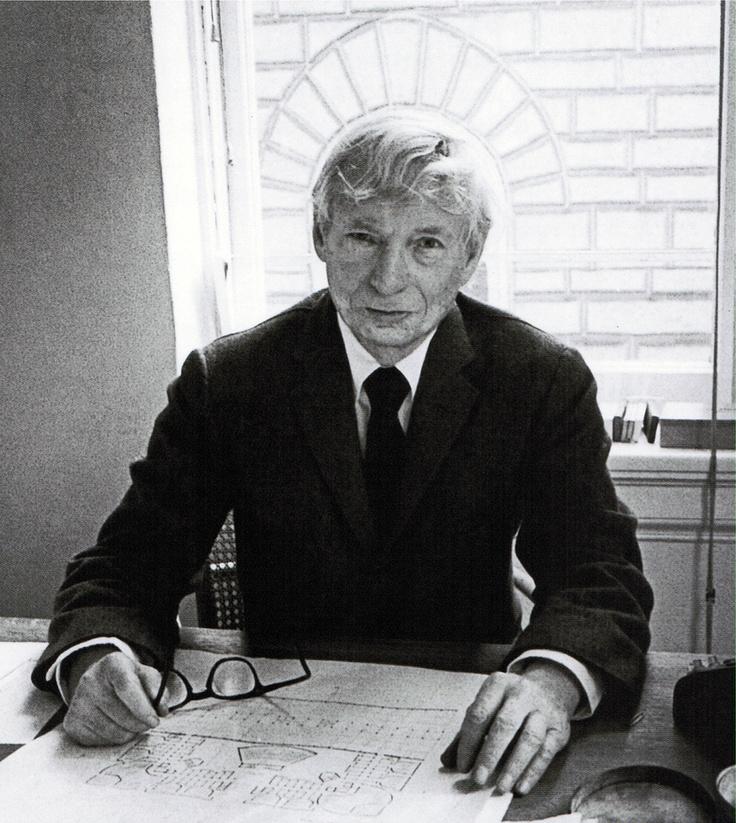Louis Isadore Kahn was an Estonian-born American architect based in Philadelphia. He was one of the most revered architects of his time and created a style that was monumental and monolithic; his heavy buildings for the most part do not hide their weight, their materials, or the way they are assembled. He was awarded the AIA Gold Medal and the RIBA Gold Medal. At the time of his death, he was considered by some as “America’s foremost living architect.”
Kahn was born on February 20, 1901, in Osel, Estonia, and died on March 17, 1974, in New York City. He immigrated with his family to the United States in 1906 and settled in Philadelphia. He graduated from the University of Pennsylvania, architecture program in 1924 and later toured Europe, studying and sketching architectural monuments. In 1941 he was in a partnership with George Howe and from 1942 to 1944 with Howe and Oscar Stonorov. Kahn worked in various capacities for several architectural firms before founding his own business.
Kahn continued practicing as an architect and became a professor at Yale School of Architecture in 1947. After a fellowship at the American Academy in Rome (1950), which deepened his appreciation of Mediterranean architecture, Kahn carried out his first important work: the Yale University Art Gallery (1952-1954) at New Haven, Connecticut, which marked a notable departure from his International Style buildings of the previous decade.
In 1957, Kahn was named professor of architecture at the University of Pennsylvania. His Richards Medical Research Building (1960-1965) at the university is outstanding for its expression of the distinction between “servant” and “served” spaces. The servant spaces (stairwells, elevators, exhaust and intake vents, and pipes) are isolated in four towers, distinct from the served spaces (laboratories and offices). Laboratory buildings had been designed this way for decades; Kahn elevated this practical feature into an architectural principle. His mature style, best exemplified by the Salk Institute for Biological Studies, La Jolla, California (1959-1965), and the Yale Center for British Art, New Haven, Connecticut (1977), combined the servant typology with inspiration from classical and medieval architecture, basic geometric forms, and elegant, expressive use of such familiar materials as concrete and brick.
Kahn’s mature style best exemplified by the Salk Institute for Biological Studies at La Jolla, California (1959-1965), and the Yale Center for British Art, New Haven, Connecticut (1977), combined the servant-served typology with inspiration from classical and medieval architecture, basic geometric forms, and an elegant expressive use of such familiar materials as concrete and brick.
Some of his notable works include:
- Yale University Art Gallery, New Haven, Connecticut (1951-1953)
- Richards Medical Research Laboratories, University of Pennsylvania, Philadelphia, Pennsylvania (1957-1965)
- The Jonas Salk Institute for Biological Studies, La Jolla, California (1959-1965)
- First Unitarian Church, Rochester, New York (1959-1969)
- Shaheed Suhrawardy Medical College and Hospital, Dhaka, East Pakistan
- Indian Institute of Management, Ahmedabad, India
- Eleanor Donnelley Erdman Hall, Bryn Mawr College, Bryn Mawr, Pennsylvania (1960-1965)
- Phillips Exeter Academy Library, New Hampshire (1965-1972)
- Kimbell Art Museum, Fort Worth, Texas (1867-1972)
- Arts United Center, Fort Wayne, Indiana (1973)
- Hurva Synagogue, Jerusalem, Israel (1968-19740
- Yale Center for British Art, Yale University, New Haven, Connecticut (1969-1974)
- Franklin D. Roosevelt Four Freedoms Park, Roosevelt Island, New York (1972-1974)
- Jatiyo Shangshad Bhaban (National Assembly Building) Dhaka, East Pakistan (1962-1974)
Louis Kahn was a complicated man who was always in deep thought. Here are a few of his original quotes:
- “Architecture is the reaching out for the truth.”
- “Consider the momentous event in architecture when the wall parted, and the column became.”
- “Design is not making beauty, beauty emerges from selection, affinities, integration, love.”
- “A great building must begin with the unmeasurable, must go through measurable means when it is being designed and, in the end, must be unmeasurable.”
In 2003 Nathaniel Kahn released a documentary about his father, My Architect: A Son’s Journey. The Oscar-nominated film provides views and insights into Kahn’s architecture while exploring him personally through his family, friends, and colleagues.
Kahn was elected a Fellow of the American Institute of Architects (AIA) in 1953. He was awarded the Frank P. Brown Medal in 1964. In 1965 he was elected into the National Academy of Design as an Associate Academician. He was made a member of the American Academy of Arts and Sciences in 1968 and awarded the AIA Gold Medal, the highest award given by the AIA, in 1971, and the Royal Gold Medal by the Royal Institute of British Architects (RIBA), in 1972. In 1971, he received the Golden Plate Award from the American Academy of Achievement.
Kahn’s work, like that of Eero Saarinen, Frei Otto, and others who broke with the International Style, was controversial during his lifetime. However, his work was reviewed more favorably by a new generation of critics, who declared him one of the most original and important architects of the 20th century.
Louis Kahn was a creative mind who successfully created many projects around the world. He managed to emigrate to the United States with no money or opportunities and work hard and attain success. His life is a blueprint for anyone who is struggling to achieve their goals. Kahn kept his eye on his goals, worked hard, and never gave up. We at Scarano Architect believe in that work ethic. That has kept us in business for over thirty years. Keep us in mind for any of your architectural needs. We would be glad to hear from you.


